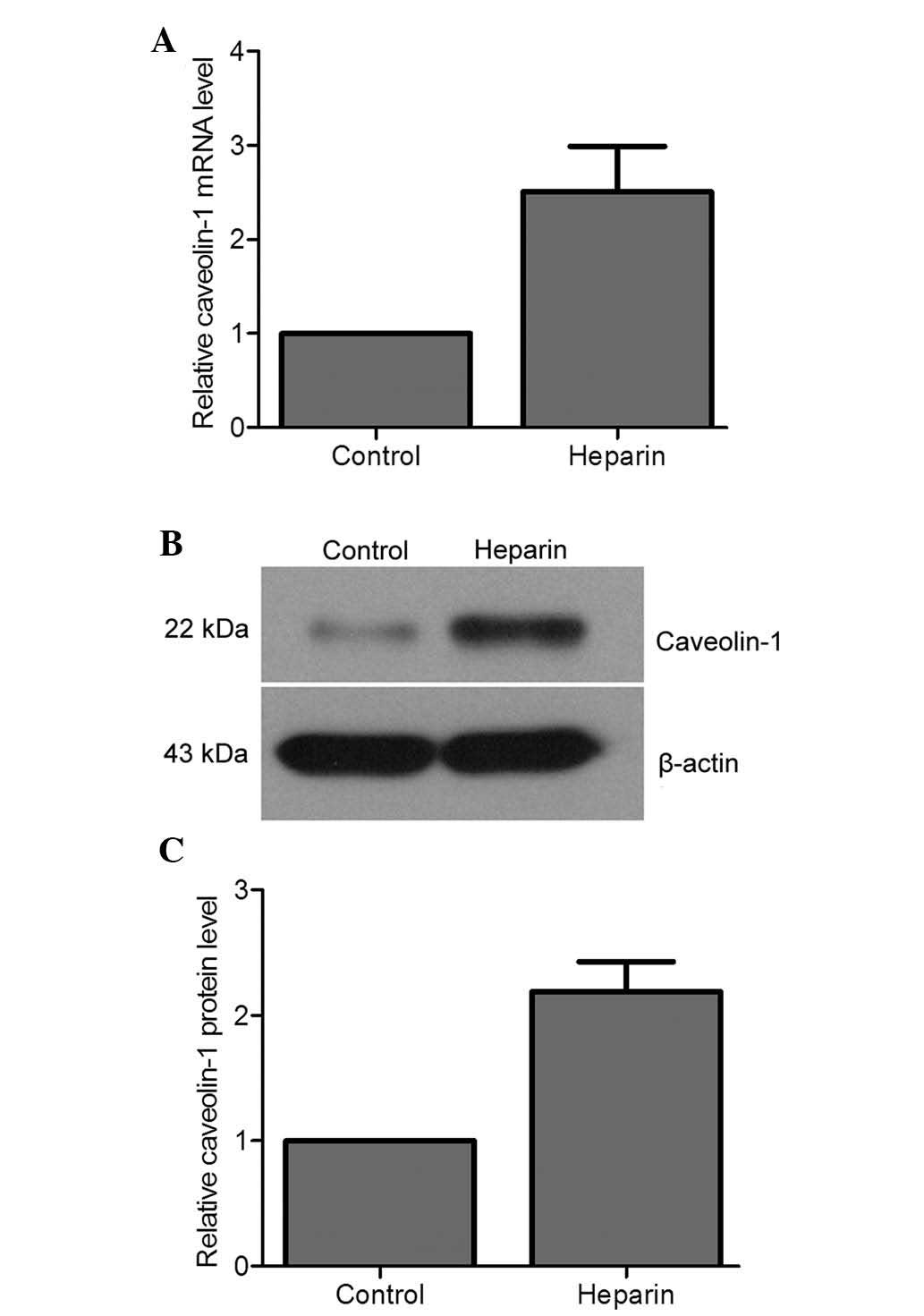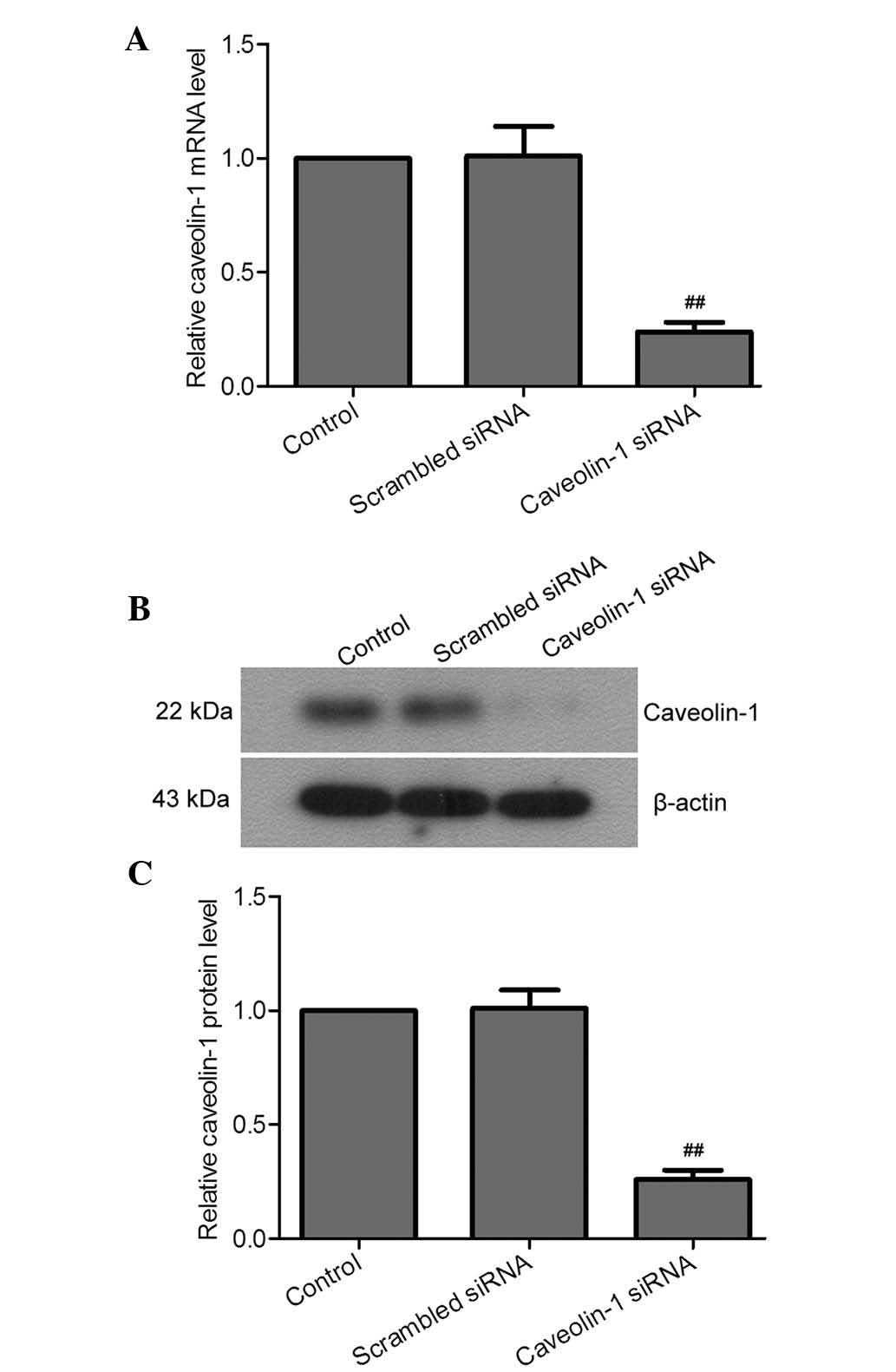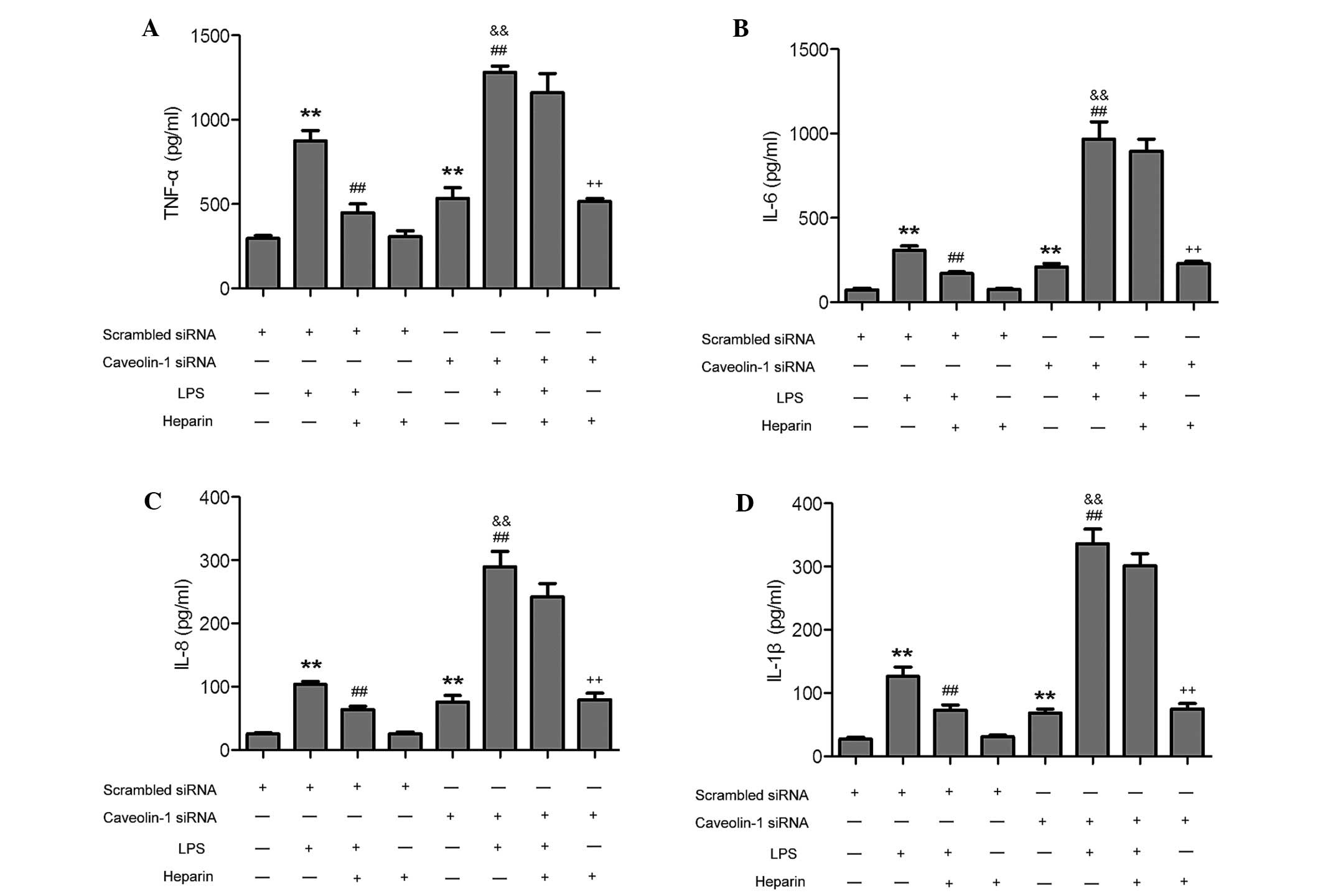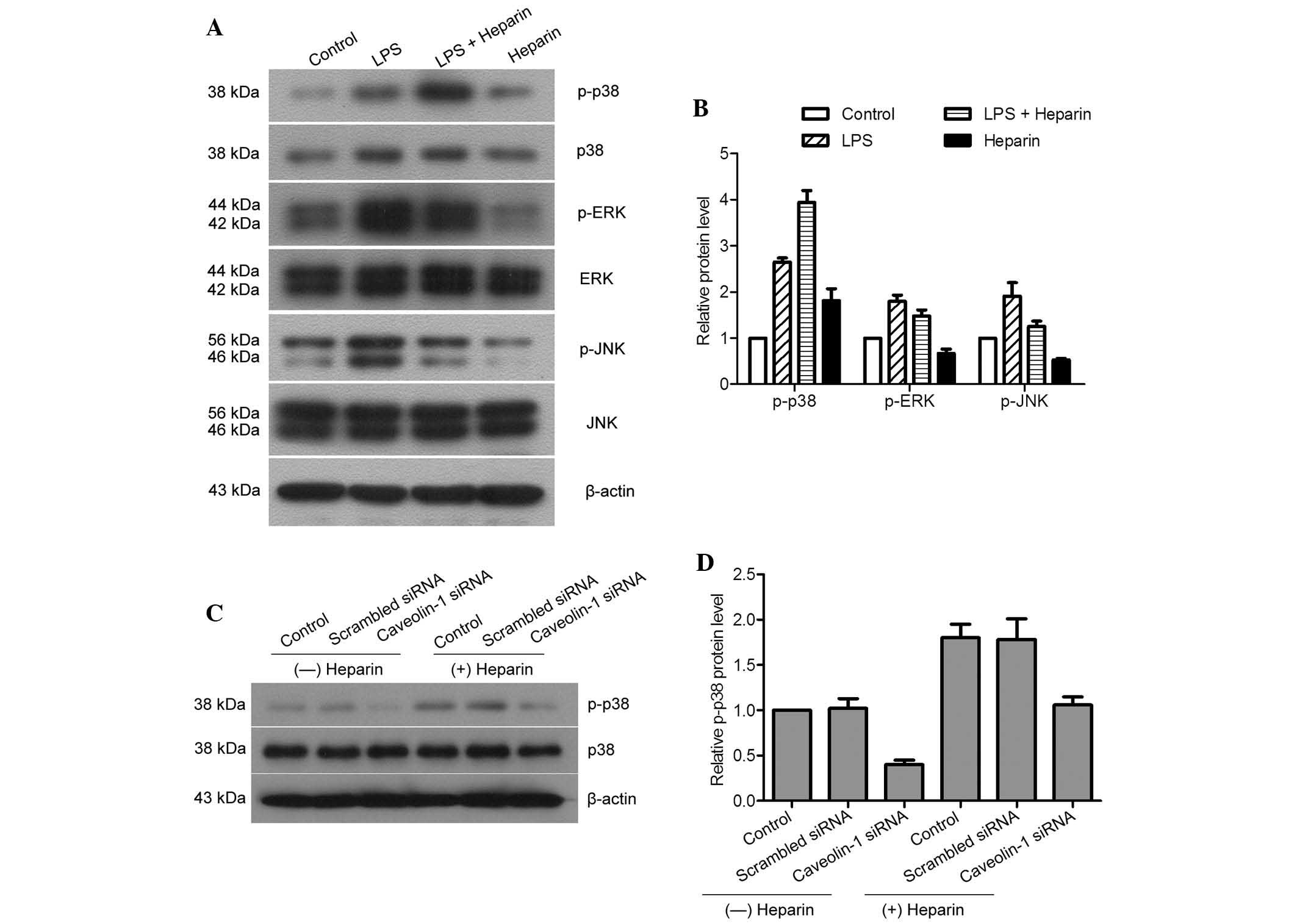Heparin inhibits lipopolysaccharide-induced inflammation via inducing caveolin-1 and activating the p38/mitogen-activated protein kinase pathway in murine peritoneal macrophages
- Authors:
- Published online on: May 21, 2015 https://doi.org/10.3892/mmr.2015.3807
- Pages: 3895-3901
Abstract
Introduction
Heparin is a potent blood anti-coagulant drug in clinical practice, and the underlying mechanisms of its anti-coagulant function have been extensively studied (1). Aside from its anti-coagulant capacity, heparin is known to modulate a wide array of inflammatory responses, partly through inhibiting the production of inflammatory factors via blocking the p38/mitogen-activated protein kinase (MAPK) and nuclear factor κ B (NF-κB) activation (2). Although the anti-inflammatory effect of heparin is well known (3), it has not been applied as an anti-inflammatory drug, not only due to the potential risk of bleeding, but also due to its complex mechanisms of action which are largely elusive. Therefore, illustrating the underlying mechanisms of the anti-inflammatory effect of heparin is required for its potential application in the clinic.
Caveolae are cholesterol- and glycosphingolipid-rich ampullate invaginations of the plasma membrane, which participate in a wide range of processes in cells (4). As the coat proteins of caveolae, caveolins have specific functions, which vary depending on the cell type. Caveolin-1 was the first protein identified as a prominent resident of caveolae (5), and it has been reported to regulate lipid metabolism, apoptosis, and endocytosis in macrophages (6–8). Caveolin-1 expressed in different types of immune cell was proved to have a critical role in modulating inflammatory responses induced by infection and disease (9,10). Interestingly, it was also reported that heparin is able to regulate caveolin-1 expression and subcellular localization in human vascular smooth muscle cells (11). However, whether the two have any interaction in the inflammatory process in peritoneal macrophages has not been studied in detail. Revealing the role of caveolin-1 in the inflammatory process regulated by heparin can further elucidate the functions of caveolin-1 and aid in the discovery of novel treatment strategies for inflammation.
Therefore, the present study investigated the effects of heparin on LPS-induced murine peritoneal macrophages as well as the underlying mechanisms. Since caveolin-1 has been linked with the modulation of the inflammatory response, the present study tested whether heparin and caveolin-1 are associated in the LPS-induced inflammatory process. Herein, to better characterize the role of caveolin-1 in LPS-induced inflammation treated by heparin, small interfering (si)RNA was used to silence caveolin-1 in murine peritoneal macrophages. The effects and mechanisms of heparin in inflammation were studied through assessing the levels of inflammatory cytokines tumor necrosis factor (TNF)-α, interleukin (IL)-6, IL-8 and IL-1β, as well as signaling molecules of the p38, extracellular signal-regulated kinase (ERK), c-Jun N-terminal kinase (JNK) and MAPK pathways, respectively.
Materials and methods
Animals, cell culture and reagents
C57BL/6 mice were provided by the Experimental Animal Centre of China Medical University (Shenyang, China). The animal study protocol was approved by the Animal Experimental Committee of China Medical University, and the mice received humane care in accordance with the Principles of Laboratory Animal Care. Peritoneal macrophages were isolated from the 6–8 week-old mice, as described previously (12). The macrophages were maintained in 10% fetal bovine serum (FBS; Hyclone, Logan, UT, USA) Dulbecco's modified Eagle's medium (DMEM; Gibco-BRL, Grand Island, NY, USA). siRNA of caveolin-1 and a scrambled non-specific sequence were stably transfected into the peritoneal macrophages, respectively, using Lipofectamine 2000 reagent (Invitrogen Life Technologies, Carlsbad, CA, USA) as per the manufacturer's instructions. Cells treated with transfection reagent only were used as the control. The cells were cultured in DMEM and maintained in an incubator at 37°C with 5% CO2. The cells were divided into different groups and stimulated with LPS (100 ng/ml; Sigma-Aldrich, St. Louis, MO, USA) and/or heparin (20 µg/ml; Qianhong Bio-Pharma Co., Ltd, Changzhou, China).
Cytokine analysis
The levels of cytokines TNF-α, IL-6, IL-8 and IL-1β induced by LPS in heparin-stimulated peritoneal macrophages with or without knockdown of caveolin-1 were measured. Briefly, the cells were centrifuged at 1,000 × g for 5 min and the supernatants were collected. The cytokine analysis was conducted using Mouse TNF-α, IL-6, IL-8 and IL-1β ELISA kits purchased from Multisciences (Hangzhou, China) according to the manufacturer's instructions.
Transfection of siRNA
Initially, four siRNA sequences targeting the caveolin-1 gene were designed and synthesized by GenePharma Co., Ltd. (Shanghai, China). The efficiency of the siRNAs was tested by quantitative polymerase chain reaction (qPCR) and western blotting. Three sequences with improved effects (CGGUUGUACCGUGCAUCAA, CAGACGAGGUGACUGAGAA and CCUUCACUGUGACAAAAUA) were used. The scrambled non-specific sequence ACGUGACACGUUCGGAGAA with no effect was used as a negative control. Cells treated with transfection reagent alone were used as the control. For transfection, cells were seeded into six-well plates and transfected with cave-olin-1 siRNA or control plasmids using Lipofectamine 2000 reagent (Invitrogen Life Technologies) as per the manufacturer's instructions. Each well received 75 pM siRNA in a volume of 200 µl, with all conditions assessed in triplicate wells. Cells were incubated for 24 h prior to subsequent treatments.
Reverse transcription-qPCR (RT-qPCR)
Total RNA extracted separately from the control, scrambled siRNA and caveolin-1 siRNA-transfected cells using the RNAsimple Total RNA kit (Tiangen Biotech Co., Ltd., Beijing, China) was treated with DNase (Tiangen Biotech Co., Ltd.). The pure RNAs were used for the synthesis of first-strand cDNA using Super Moloney's murine leukemia virus reverse transcriptase (BioTeke, Beijing, China). Table I lists the specific primers used for qPCR analysis. The amplified products were quantitated using SYBR Green (Beijing Solarbio Science & Technology Co., Ltd., Beijing, China) fluorescence on an Exicycler™ 96 (Bioneer Corporation, Daejeon, Korea) under the following conditions: 95°C for 10 min, followed by 40 cycles at 95°C for 10 sec, 60°C for 10 sec and 72°C for 30 sec. Data were analyzed using the 2−ΔΔCt method.
Western blot analysis
For western blot analysis, protein was extracted from the transfected and treated cells. After the protein concentration was determined, aliquots of 40 µg protein were boiled in phosphate-buffered saline (PBS) with 5X loading buffer (Beijing Solarbio Science & Technology Co., Ltd.). Proteins separated by SDS-PAGE (8%, 10% and 12% polyacrylamide gels; Beijing Solarbio Science & Technology Co., Ltd.) were transferred onto polyvinylidene difluoride membranes (EMD Millipore, Billerica, MA, USA) using an electroblot apparatus (DYCZ-40D; Beijing, China). Membranes were blocked in 5% nonfat milk and incubated separately with the following primary antibodies: Rabbit polyclonal anti-caveolin-1 (1:100; cat. no. sc-894), rabbit polyclonal anti-ERK1/2 (1:100; cat. no. sc-292838), mouse monoclonal anti-JNK (1:100; cat. no. sc-137018), rabbit polyclonal p38 (1:100; cat. no. sc-535) and their phosphorylated equivalents rabbit polyclonal p-ERK1/2 (1:100; cat. no. sc-23759-R), mouse monoclonal p-JNK (1:100; cat. no. sc-6254) and rabbit polyclonal p-p38 (1:1,00; cat. no. sc-17852-R), all obtained from Santa Cruz Biotechnology, Inc (Dallas, TX, USA), and mouse horseradish peroxidase (HRP)-conjugated anti-β-actin (1:10,000; cat. no. KC-5A08; Kangchen Bio-Tech, Inc., Shanghai, China), at 4°C overnight with gentle agitation. After washing with Tris-buffered saline containing Tween 20 (TTBS; Beijing Solarbio Science & Technology Co., Ltd.), membranes were incubated with the appropriate HRP-conjugated goat anti-mouse (cat. no. A0216) and anti-rabbit (cat. no. A0208) secondary antibodies (1:5,000; Beyotime Institute of Biotechnology, Haimen, China) for 45 min at 37°C. Membranes were then washed with TTBS and protein bands were visualized using enhanced chemiluminescence (ECL) reagent (7 Seapharmtech, Shanghai, China) on X-ray film. The protein expression levels was quantified by Gel-Pro Analyzer Version 3.0 (Media Cybernetics, Silver Spring, MD, USA).
Statistical analysis
Values are expressed as the mean ± standard deviation (SD). All raw data were analyzed by one-way analysis of variance followed by the Bonferroni's post-hoc test. Statistical analyses were conducted using SPSS version 17.0 (SPSS Inc., Chicago, IL, USA). A P-value less than 0.05 was considered to indicate a statistically significant difference between values.
Results
Heparin decreases the transcription and concentration of LPS-induced inflammatory cytokines in murine peritoneal macrophages
Heparin is a potential therapeutic inhibitor of inflammation due to its ability to attenuate LPS-induced production of inflammatory cytokines in human monocytes (13). The effects of heparin on LPS-induced transcription and expression of inflammatory cytokines in murine peritoneal macrophages were assessed at 24 h after LPS and heparin co-stimulation or separate treatment. As shown in Fig. 1, TNF-α, IL-6, IL-8 and IL-1β transcription levels and protein concentrations were found to be low in untreated and heparin-treated samples, while they were strongly increased following LPS stimulation, and reduced by heparin upon LPS and heparin co-stimulation. 100 ng/ml LPS induced 2.74-, 4.30-, 4.04- and 4.54-fold increases in TNF-α, IL-6, IL-8 and IL-1β protein concentration, and 2.28-, 2.52-, 1.99- and 2.84-fold increases in transcription levels, respectively, compared to those in the control. Co-incubation with heparin and LPS resulted in a significant reduction of all inflammatory cytokines compared with those following LPS treatment alone. Protein concentrations of TNF-α, IL-6, IL-8 and IL-1β were decidedly decreased by 37.4, 45.5, 42.0 and 35.7%, and the transcription was correspondingly inhibited by 36, 35.7, 36.7 and 44.4%, respectively, with the addition of 100 ng/ml LPS and 20 µg/ml heparin compared to levels following LPS treatment alone. Treatment of murine peritoneal macrophages with heparin alone had little effect on any of the inflammatory cytokines at the transcription or protein level, with results similar to those of untreated samples. Overall, heparin was able to decrease the levels of LPS-induced inflammatory cytokines in murine peritoneal macrophages.
Heparin induces transcription and expression of caveolin-1 in murine peritoneal macrophages
Heparin has been reported to regulate the expression and sub-cellular localization of caveolin-1 in human vascular smooth muscle cells (11). To determine the association between heparin and caveolin-1 in murine peritoneal macrophages, the transcription and protein expression levels of caveolin-1 were quantitated under heparin treatment. It was shown that heparin markedly enhanced the expression of caveolin-1 at the mRNA (Fig. 2A) and protein (Fig. 2B and C) levels. A 2.51- and a 2.19-fold increase in mRNA and protein levels, respectively, of caveolin-1 was detected compared with that in the control. These results suggested that heparin is able to induce the transcription and expression of caveolin-1 in murine peritoneal macrophages.
Caveolin-1 is essential for heparin to decrease LPS-induced inflammatory cytokines in murine peritoneal macrophages
Caveolin-1 has been reported to confer anti-inflammatory effects in murine macrophages (12). To assess the function of caveolin-1 in the heparin-mediated reduction of the concentration of the LPS-induced inflammatory cytokines TNF-α, IL-6, IL-8 and IL-1β by heparin in murine peritoneal macrophages, caveolin-1 was silenced through transfection of siRNA specifically targeting mRNA sequences of caveolin-1 into murine peritoneal macrophages. At 24 h post-transfection, the mRNA and protein levels of caveolin-1 siRNA cells were significantly decreased compared to those in the scrambled siRNA-transfected and control cells (Fig. 3). The transfected cells were subsequently incubated with LPS and/or heparin, followed by assessment of mRNA and protein levels of the inflammatory cytokines. In the caveolin-1 knockdown group, LPS-induced increases in the inflammatory cytokines TNF-α, IL-6, IL-8 and IL-1β in murine peritoneal macrophages were greater than those in the scrambled siRNA group. Of note, co-treatment with heparin LPS-induced increases of inflammatory cytokines TNF-α, IL-6, IL-8 and IL-1β were significantly abrogated in the scrambled siRNA group, while heparin did not significantly decrease the levels of these cytokins in the caveolin-1 siRNA group (Fig. 4). Treatment of transfected murine peritoneal macrophages with heparin alone had no effects on the levels of any of the inflammatory cytokines. Hence, caveolin-1 was essential for heparin to decrease the concentration of LPS-induced inflammatory cytokines in murine peritoneal macrophages.
Effect of heparin on the MAPK pathway and the mechanisms of p38/MAPK activation in murine peritoneal macrophages
It has been reported that heparin can inhibit the LPS-induced inflammatory response through blocking the activation of the p38/MAPK pathway in endothelial cells (2). To clarify the association between heparin and the MAPK pathway in LPS-induced murine peritoneal macrophages, the expression levels of p-ERK, ERK, p-JNK, JNK, p-p38 and p38 were assessed in heparin- and/or LPS-treated cells. The results demonstrated that LPS increased the expression of p-ERK, p-JNK and p-p38, while heparin could increase the expression of p-p38 only (Fig. 5A and B). LPS-induced increases in p-ERK and p-JNK were inhibited by heparin, while the reduced expression of p-JNK was more severe than that of p-ERK. Downregulation of caveolin-1 attenuated the expression of p-p38. However, the expression levels of p-p38 were increased in the presence of heparin compared with those in the heparin-untreated groups, even when caveolin-1 was knocked down in the murine peritoneal macrophages (Fig. 5C and D). Therefore, heparin was able to activate the p38/MAKP pathway and inhibit ERK and JNK pathways in LPS-induced inflammation of murine peritoneal macrophages. However, heparin was also able to activate p38 through inducing caveolin-1 as well as by itself.
Discussion
Heparin is a soluble glycosaminoglycan, which is well known for its anti-coagulant properties and anti-inflammatory effects (14). It has been reported that heparin can suppress the lethal response to acute lung injury associated with sepsis through inhibiting inflammatory responses (15). However, it has remained elusive whether heparin can regulate inflammatory responses in murine peritoneal macrophages. In the present study, the heparin-mediated regulation of the induction of inflammatory cytokines by LPS was assessed in murine peritoneal macrophages. As expected, TNF-α, IL-6, IL-8 and IL-1β were upregulated by LPS at the transcriptional and at the protein level, while all cytokines were significantly reduced by co-treatment with heparin. This indicated that heparin induced a strong decrease in inflammation of murine peritoneal macrophages. The results demonstrated that the observed reduction of LPS-induced inflammatory cytokines by heparin treatment in murine peritoneal macrophages is in agreement with similar studies performed on human cells and mice (16,17). Therefore, heparin may represent a potential inhibitory agent in inflammation through reducing the release of inflammatory cytokines.
Caveolin-1 has numerous functions, including participation in macromolecular transport and permeability, cardiac hypertrophy, intercellular calcium, regulation of the vascular reactivity, blood pressure, redox signaling and function, as well as mechanotransduction (18,19). Caveolin-1 was previously shown to be a potent immunomodulatory molecule in murine macrophages (12), and also to be regulated by heparin (11). To date, to the best of our knowledge, the association between caveolin-1 and heparin in inflammation has not been evidenced. The present study showed that heparin induced high expression of caveolin-1 in murine peritoneal macrophages. Furthermore, levels of the inflammatory cytokines TNF-α, IL-6, IL-8 and IL-1β were higher in caveolin-1-silenced cells than those in scrambled siRNA-transfected cells, indicating that caveolin-1 itself had anti-inflammatory effects in murine macrophages. Hence, induction of caveolin-1 was an important mechanism of heparin in anti-inflammation. In addition, downregulation of caveolin-1 inhibited the effects of heparin on LPS-induced inflammatory cytokines. Upon caveolin-1-silencing, heparin lost its ability to decrease LPS-induced inflammatory cytokines, compared with that in scrambled siRNA-transfected cells. This suggested that caveolin-1 was an essential factor for heparin during the reduction of the concentration of LPS-induced inflammatory cytokines in murine peritoneal macrophages. As heparin can bind to numerous proteins non-specifically, the underlying mechanisms of its anti-inflammatory action are complex and have remained to be fully elucidated. Interacting with inflammatory cytokines and basic fibroblast growth factor (bFGF) as well as binding to acute phase and complementary proteins may also contribute to the anti-inflammatory effect of heparin (20). The results of the present study indicated that caveolin-1 may be a novel and necessary target of heparin in the efficient anti-inflammatory process.
MAPKs are a family of intracellular kinases, and the MAPK signal transduction pathway serves as a focal point for ubiquitous and highly evolutionarily conserved mechanisms of diverse extracellular stimulating responses and various cellular process regulations (21). The ERKs, JNK and p38 are identified as the cores of the MAPK pathway, and they can be activated by environmental stresses and inflammatory mediators (22). The expression levels of caveolin-1 are positively correlated with p38 activation and anti-inflammatory effects, while they are negatively correlated with ERK or JNK in murine macrophages (12). It was found that heparin had the same effects in LPS-induced murine peritoneal macrophages and exerted anti-inflammatory effects through activating p38, while, at the same time, inhibiting ERK and JNK pathways. The anti-inflammatory effects of heparin may have been based on inducing caveolin-1, which actually took charge of activating the p38/MAPK pathway. However, when caveolin-1 was silenced, heparin was still able to activate the p38/MAPK pathway as evidenced by increased expression of p-p38. These results indicated that heparin had anti-inflammatory effects in LPS-induced murine peritoneal macrophages via multiple signaling pathways, including the induction of caveolin-1, activation of p38 and inhibition of ERK and JNK pathways. By contrast, unfractionated heparin has been reported to inhibit LPS-induced inflammation through blocking p38/MAPK and NF-κB activation in endothelial cells (2). This confirmed the anti-inflammatory effects of heparin, while various mechanisms of action may be relevant in different cell types. Whenever heparin is used as the anti-inflammatory agent, however, the effects are mediated via the p38/MAPK pathway.
In conclusion, the present study demonstrated the anti-inflammatory effects and mechanisms of heparin in LPS-induced murine peritoneal macrophages. Heparin has a protective role in inflammation by suppressing the production of the inflammatory cytokines TNF-α, IL-6, IL-8 and IL-1β. High expression of caveolin-1 induced by heparin can enhance the anti-inflammatory effects, and caveolin-1 is a necessary factor for efficient anti-inflammatory action by heparin. The present study also provided evidence that the effects of heparin involve activation of the p38/MAPK signaling pathway through inducing caveolin-1 as well as by itself. It was further observed that heparin increased LPS-induced activation of p38 and decreased activation of ERK and JNK, which may be further mechanisms underlying its anti-inflammatory effects. These results indicated that heparin has the potential to be the drug of first choice in treating hemorrhagic inflammation.
References
|
Barrow RT, Parker ET, Krishnaswamy S and Lollar P: Inhibition by heparin of the human blood coagulation intrinsic pathway factor X activator. J Biol Chem. 269:26796–26800. 1994.PubMed/NCBI | |
|
Li X, Zheng Z, Li X and Ma X: Unfractionated heparin inhibits lipopolysaccharide-induced inflammatory response through blocking p38 MAPK and NF-κB activation on endothelial cell. Cytokine. 60:114–121. 2012. View Article : Google Scholar : PubMed/NCBI | |
|
Lever R and Page C: Non-anticoagulant Effects of Heparin: An Overview. Heparin-A Century of Progress. 207. Lever R, Mulloy B and Page CP: Springer; Berlin Heidelberg: pp. 281–305. 2012, View Article : Google Scholar | |
|
Hansen CG and Nichols BJ: Exploring the caves: cavins, caveolins and caveolae. Trends Cell Biol. 20:177–186. 2010. View Article : Google Scholar : PubMed/NCBI | |
|
Rothberg KG, Heuser JE, Donzell WC, Ying YS, Glenney JR and Anderson RG: Caveolin, a protein component of caveolae membrane coats. Cell. 68:673–682. 1992. View Article : Google Scholar : PubMed/NCBI | |
|
Fernández-Rojo MA, Gongora M, Fitzsimmons RL, et al: Caveolin-1 is necessary for hepatic oxidative lipid metabolism: Evidence for crosstalk between caveolin-1 and bile acid signaling. Cell Rep. 4:238–247. 2013. View Article : Google Scholar : PubMed/NCBI | |
|
Meyer C, Liu Y, Kaul A, Peipe I and Dooley S: Caveolin-1 abrogates TGF-[beta] mediated hepatocyte apoptosis. Cell Death Dis. 4:e4662013. View Article : Google Scholar | |
|
Li J, Scherl A, Medina F, Frank PG, Kitsis RN, Tanowitz HB, Sotgia F and Lisanti MP: Impaired phagocytosis in caveolin-1 deficient macrophages. Cell Cycle. 4:1599–1607. 2005. View Article : Google Scholar : PubMed/NCBI | |
|
Gadjeva M, Paradis-Bleau C, Priebe GP, Fichorova R and Pier GB: Caveolin-1 modifies the immunity to pseudomonas aeruginosa. J Immunol. 184:296–302. 2010. View Article : Google Scholar : | |
|
Feng H, Guo L, Song Z, et al: Caveolin-1 protects against sepsis by modulating inflammatory response, alleviating bacterial burden and suppressing thymocyte apoptosis. J Biol Chem. 285:25154–25160. 2010. View Article : Google Scholar : PubMed/NCBI | |
|
Peterson TE, Kleppe LS, Caplice NM, Pan S, Mueske CS and Simari RD: The regulation of caveolin expression and localization by serum and heparin in vascular smooth muscle cells. Biochem Biophys Res Commun. 265:722–727. 1999. View Article : Google Scholar : PubMed/NCBI | |
|
Wang XM, Kim HP, Song R and Choi AM: Caveolin-1 confers antiinflammatory effects in murine macrophages via the MKK3/p38 MAPK pathway. Am J Respir Cell Mol Biol. 34:434–442. 2006. View Article : Google Scholar | |
|
Hochart H, Vincent Jenkins P, Smith OP and White B: Low-molecular weight and unfractionated heparins induce a downregulation of inflammation: decreased levels of proinflammatory cytokines and nuclear factor-κB in LPS-stimulated human monocytes. Br J Haematol. 133:62–67. 2006. View Article : Google Scholar : PubMed/NCBI | |
|
Jin-ping Li IV: Heparin, heparan sulfate and heparanase in inflammatory reactions. Thrombosis and haemostasis. 102:799–1006. 2009. | |
|
Zhao D, Ding R, Mao Y, Wang L, Zhang Z and Ma X: Heparin rescues sepsis-associated acute lung injury and lethality through the suppression of inflammatory responses. Inflammation. 35:1825–1832. 2012. View Article : Google Scholar : PubMed/NCBI | |
|
Spratte J, Meyer zu Schwabedissen H, Endlich N, Zygmunt M and Fluhr H: Heparin inhibits TNF-α signaling in human endometrial stromal cells by interaction with NF-κB. Mol Hum Reprod. 19:227–236. 2012. View Article : Google Scholar | |
|
Ding R, Zhao D, Guo R, Zhang Z and Ma X: Treatment with unfractionated heparin attenuates coagulation and inflammation in endotoxemic mice. Thromb Res. 128:e160–e165. 2011. View Article : Google Scholar : PubMed/NCBI | |
|
Sowa G: Caveolae, caveolins, cavins and endothelial cell function: new insights. Front Physiol. 2:1202012. View Article : Google Scholar | |
|
Anderson RG: Caveolae: where incoming and outgoing messengers meet. Proc Natl Acad Sci USA. 90:10909–10913. 1993. View Article : Google Scholar : PubMed/NCBI | |
|
Young E: The anti-inflammatory effects of heparin and related compounds. Thromb Res. 122:743–752. 2008. View Article : Google Scholar | |
|
Yong HY, Koh MS and Moon A: The p38 MAPK inhibitors for the treatment of inflammatory diseases and cancer. Expert Opin Investig Drugs. 18:1893–1905. 2009. View Article : Google Scholar : PubMed/NCBI | |
|
Kyriakis JM and Avruch J: Mammalian MAPK signal transduction pathways activated by stress and inflammation: A 10-year update. Physiol Rev. 92:689–737. 2012. View Article : Google Scholar : PubMed/NCBI |














